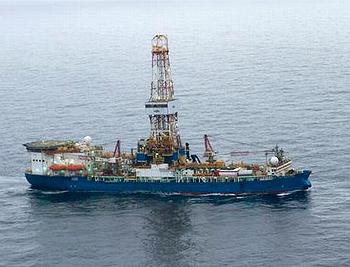
JUNEAU, Alaska, August 7, 2013 (ENS) – The U.S. government complied with the law when it approved Shell Oil’s plans for preventing and cleaning up an oil spill in the Arctic Ocean’s Chukchi and Beaufort seas, the U.S. District Court in Alaska ruled Monday.
U.S. District Judge Ralph Beistline found the Bureau of Safety and Environmental Enforcement, BSEE, a division of the U.S. Department of the Interior, was not required to conduct an assessment under the National Environmental Policy Act and did not have to determine whether its approvals would impact federally protected species or their habitat.
In 2012, Shell started drilling the first wells in the Alaskan Arctic in nearly two decades in the Beaufort and Chukchi Seas. Shell’s goal for the 2012 summer drilling season was to confirm a major discovery of oil in commercially-viable quantities in the Alaskan Arctic Ocean.

Shell was not able to achieve its goal and did not complete any exploration wells. The company experienced major problems with both its drill ships that raised what an Interior Department review issued in March called “serious questions regarding its ability to operate safely and responsibly in the challenging and unpredictable conditions offshore Alaska.”
Judge Beistline’s ruling validates the government’s decision not to follow either the National Environmental Policy Act or the Endangered Species Act before it approved Shell’s plans.
The approvals were not authorizing a project or activity, the judge wrote, but were stating that the plans met regulatory and statutory requirements ensuring that Shell could respond to a so-called “worst-case discharge.”
The decision comes in a lawsuit filed by a coalition of conservation organizations made up of the Alaska Wilderness League, Center for Biological Diversity, Greenpeace, National Audubon Society, Natural Resources Defense Council, Ocean Conservancy, Oceana, Pacific Environment, Resisting Environmental Destruction on Indigenous Lands, and Sierra Club.
Earthjustice, a nonprofit environmental law firm, represented the organizations.
“We can all agree that we want oil companies to have sufficient resources and realistic plans to cleanup an oil spill,” said Earthjustice Attorney Holly Harris on Tuesday. “Yesterday, the first court to address the issue said the spill plans were sufficient, but this is only the beginning of the effort to define the obligations to address oil spill prevention and response, especially in remote, isolated areas like the Arctic Ocean.”
In a joint statement, the organizations said the ruling “upholds spill plans based on Shell Oil’s assumption that it will clean up 95 percent of any spilled oil before it contacts the shoreline – a level of success that has never before been achieved. Even in the Gulf of Mexico, with easy access to substantial response resources, skimming recovery efforts during the Deepwater Horizon disaster recovered just three percent of the total amount of oil released.”

“Shell’s plans are based on unrealistic assumptions and unproven technologies. If these plans satisfy the law, then the law is broken. Particularly after the disastrous 2012 season, the government cannot simply take Shell’s word that the company is prepared,” said Susan Murray, Oceana’s deputy vice president, Pacific. “Instead, government decision-makers must insist that companies prove they can operate safely and without harming the ocean ecosystem before allowing exploration in the Arctic Ocean.”
Shell was unable to obtain certification of its containment vessel, the Arctic Challenger, on a timely basis and had difficulty with deployment of the Arctic Challenger’s containment dome. Marine transport issues hampered both of Shell’s drilling rigs, the Noble Discoverer and the Noble Kulluk, including the grounding of the Kulluk off Kodiak Island during a towing operation last December.
“The ruling doesn’t change the fact that, as Shell’s misadventures last year showed, the Arctic Ocean is no place for rosy-eyed optimism. In fact, until and unless clean-up technology has been proven effective, reliable, and benign in the Arctic, it’s no place to drill at all,” the plaintiff groups said.
“As Shell’s problems in 2012 showed clearly, oil companies are not prepared to drill in the Arctic Ocean,” the groups said. “The announcements that Shell, ConocoPhillips, and other companies have announced that they will not seek to drill exploration wells this year provides an opportunity to revisit the pre-Deepwater Horizon regulations and requirements that govern important protections, like spill plans.”
Shell U.S. spokesman Curtis Smith told reporters that the ruling means the Bureau of Safety and Environmental Enforcement was thorough in its analysis of the company’s oil spill response plan.
Shell has not announced any plans for future Arctic drilling. Smith said, “Future exploration plans for offshore Alaska will depend on a number of factors, including the readiness of necessary assets and confidence that lessons learned from 2012 have been fully incorporated.”
The groups say this court case is just a “first step” and they have no intention of abandoning their objections to Arctic drilling.
“We brought this case to ensure that industry and regulators meet the law’s requirements to ask tough questions and reach defensible positions before companies are allowed to drill – and to ensure that operators are prepared to mount an effective cleanup in the event of a spill,” the groups said. “The court’s decision is a setback, but we will continue to push for responsible planning and stringent enforcement of legal protections.”
Copyright Environment News Service (ENS) 2013. All rights reserved.
